Harpy Eagle Nest
One of the ornithological highlights of my year was a trek to see the nest of a harpy eagle near Surama Eco-Lodge. There are around 200 known harpy eagle nests in the bird's entire range. Looking down on the unbroken green carpet beneath our airplane or from a promontory, I would imagine and hope that there are more than 200 nests on the planet, but that number serves to give you an idea just how rare an opportunity this would be.
I was glad to see the trail not well-maintained or easily traversed. In fact, walking it was like doing hundreds of leg-lifts as we hopped, stepped and scrambled over log after fallen log. Add a few dozen pounds of camera and optical gear, hike the temperature to about 98 and the humidity to God knows where, and it was like doing aerobics in a sauna. In contrast to those of us who were sweating through our layers of protective clothing, getting funkier by the minute (at 7 AM, no less!) one local birder looked perfectly comfortable. Beautiful, in fact.
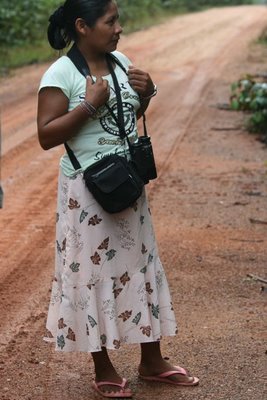 I will never cease to marvel at anyone who can navigate tropical lowland forest in a filmy butterfly skirt and flip-flops. I would be convinced that something unknown would run up my leg, or that I'd be impaled on one of the billions of spikes and thorns with which all tropical vegetation bristles. And surely it would, and I would.
I will never cease to marvel at anyone who can navigate tropical lowland forest in a filmy butterfly skirt and flip-flops. I would be convinced that something unknown would run up my leg, or that I'd be impaled on one of the billions of spikes and thorns with which all tropical vegetation bristles. And surely it would, and I would.She made it just fine. This is her habitat, and with every cell of her body she is adapted to it as surely as I am to the slippery hills and hollers of Appalachian Ohio. I love looking at people just like I look at animals, seeing us as part of an evolutionary continuum and not something set apart.
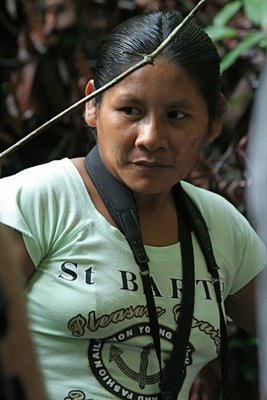 It's OK to do that, whatever the traditional Christian view tells us about our apartness, our supposed dominion over the fish and fowl and beasts. I don't buy it. In my view, we're much more a cog in a big, beautiful machine than the operator of said machine. Mostly, it seems, we're here to mess it up. We throw an ecological wrench into the works every day, every chance we get, but in the end, we're a tiny moving part in a much greater whole. This is a truth she knows in her bones. It is one that most of the rest of us are never able to grasp. And the spikes and the spines seem to part before her, and they tug at our sleeves.
It's OK to do that, whatever the traditional Christian view tells us about our apartness, our supposed dominion over the fish and fowl and beasts. I don't buy it. In my view, we're much more a cog in a big, beautiful machine than the operator of said machine. Mostly, it seems, we're here to mess it up. We throw an ecological wrench into the works every day, every chance we get, but in the end, we're a tiny moving part in a much greater whole. This is a truth she knows in her bones. It is one that most of the rest of us are never able to grasp. And the spikes and the spines seem to part before her, and they tug at our sleeves.There was so much to look at, but the hike was almost two miles, and we had to keep moving. This little nymph reminded me of some of our satyrs back home.
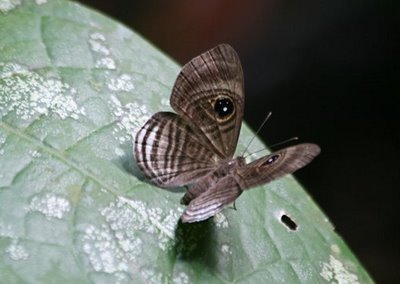
Finding itself observed, it quickly flitted to hang upside down on the underside of a leaf.

There's so much hiding going on all the time; if it's not cryptic coloration it's cryptic behavior like this. And eyespots to startle and confuse as well.
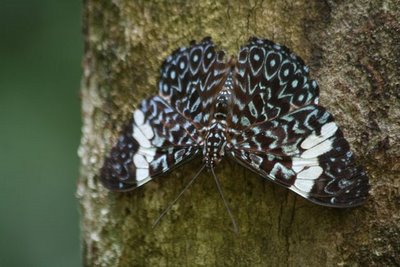
This is one of the cracker butterflies, so called because its wings snap loudly when it takes off. Crackers like to hang head-down, ready for anything. Kevin Loughlin said this one reminded him of a species called starry night cracker. What a lovely name, even if it's not the right one. Once again I had to be content with getting close, without the satisfaction of a taxonomic cigar.
For the entire hike, I kept myself occupied with the wondrous things all around me, careful not to become so focused on seeing a harpy eagle that the trip would be ruined without reaching that goal. But when the nest finally hove into sight, all those resolutions crumbled. I desperately wanted to see the bird that made this huge pile of sticks, or perhaps the eaglet who came out of it.
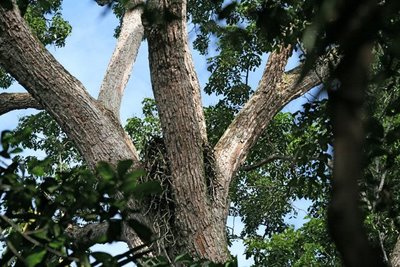 It's hard to convey just how huge this tree, this nest, really was. Harpies often choose to nest in ceiba trees, the largest emergents in most lowland forest, and a tree that, by some incredible grace, is often revered enough that it is considered bad luck to cut them. Whether that is connected to the fact that it's the tree preferred by nesting harpies, I am left to wonder. I remain wary of the apparent charity of man: traced to its roots, it is usually revealed to be self-serving. Whatever the reason, this ceiba survived the cutting, and the powerful birds who call it home were allowed to stay. It bothers me that we, avaricious and destructive primates that we are, are endowed with the power to grant such a thing.
It's hard to convey just how huge this tree, this nest, really was. Harpies often choose to nest in ceiba trees, the largest emergents in most lowland forest, and a tree that, by some incredible grace, is often revered enough that it is considered bad luck to cut them. Whether that is connected to the fact that it's the tree preferred by nesting harpies, I am left to wonder. I remain wary of the apparent charity of man: traced to its roots, it is usually revealed to be self-serving. Whatever the reason, this ceiba survived the cutting, and the powerful birds who call it home were allowed to stay. It bothers me that we, avaricious and destructive primates that we are, are endowed with the power to grant such a thing.Next: A harpy eagle, up close and a little too personal.
Labels: birding in Guyana, Guyana, Harpia harpyja, harpy eagle, harpy eagle nest, manifest destiny






<< Home